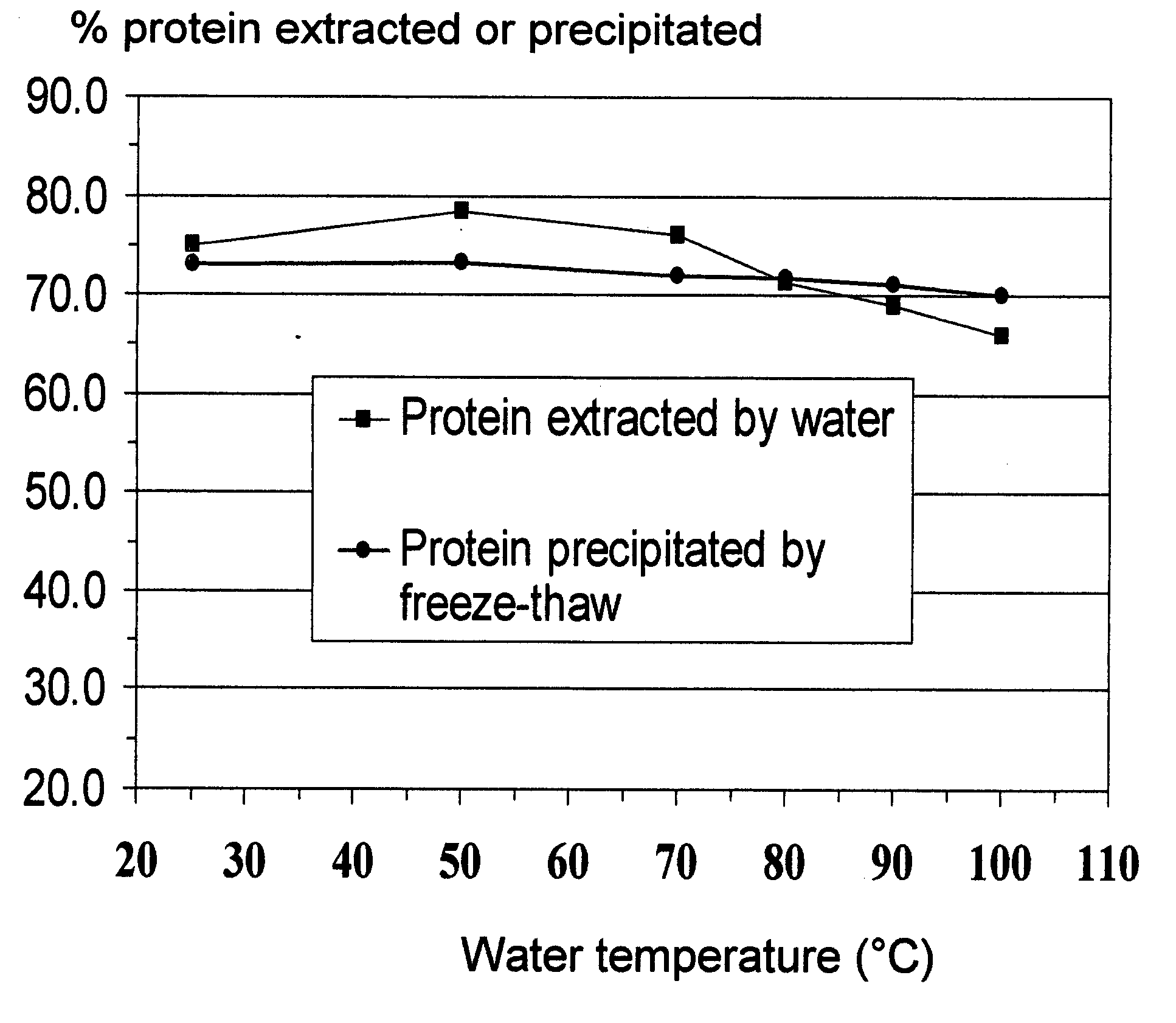Methods of extracting, concentrating and fractionating proteins and other chemical components
a technology of protein and chemical components, applied in the field of methods for extracting, concentrating and fractionating proteins, can solve the problems of poor taste and flavor, poor nutritional quality, and inability to meet the needs of consumers, and achieve the effect of high protein extraction rate, and improved protein extraction ra
- Summary
- Abstract
- Description
- Claims
- Application Information
AI Technical Summary
Benefits of technology
Problems solved by technology
Method used
Image
Examples
example 1
Effects of Extracting Temperatures
[0106] To demonstrate the effect of extracting temperature on protein extracted and then precipitated in the subsequent freezing-thaw treatment, the following experiment was conducted, using defatted soy meal having a NSI of 84% (white flakes). To a 1.5 liter cup fitted to a home blender, 1000 ml of water was added. The water temperature varied at 25, 50, 70, 80, 90, and 100° C. for each trial. After adding 70 g of white flakes, the mixture was blended for 2 min at a higher speed. The slurry samples were filtered through cloth immediately. The filtrates were measured for protein content. The filtrates were frozen at a home refrigerator's freezing chamber for 5 days, and thawed at a refrigerator temperature for 48 hrs.
[0107] The protein in the filtrate extracted from defatted soy flakes precipitated as a result of the freeze-thaw treatment. The supernatant was carefully decanted and tested for protein content. The residue was precipitated protein. ...
example 2
Effect of Duration of Cold Temperature Treatment on Cryoprecipitation
[0109] To a 1.5 liters cup fitted to a home blender, 1000 ml of tap water and 75 g of defatted soy white flakes (with a NSI of 84) were added, and blended immediately for 1.5 min at a higher speed. The slurry was filtered through cloth. The filtrate was poured into 6 bottles, each containing 100 ml. The remaining filtrate served as a sample for zero time of freezing. Its protein concentration was tested. The other six samples were frozen at a home refrigerator's freezing chamber for various durations: 4 hours, 12 hours, 1 day, 2 days, 4 days and 6 days, respectively. At each of 6 durations of freezing the sample was taken out and thawed at a room temperature for 3 hr and then at a refrigerator for additional 20 hrs. The protein in the extract precipitated as a result of the freeze-thaw treatment. The supernatant was decanted carefully and saved. It was mixed well and tested for protein concentration. The amount of...
example 3
Effects of Additives or Acidification on Cryoprecipitation
[0112] To investigate the effect of certain additives or pH adjustments, the following experiment was conducted using full-fat soy flour. To 1.5 liters cup fitted to a home blender (Oster), 75 g of full-fat soy flour and 1000 ml of tap water were added and then blended for 2 minutes. The slurry was filtered through cloth immediately. The filtrate was measured for protein content. The filtrate (extract) was divided into 7 portions, each equaling to 100 ml. To series portions of the extract, the following chemicals were added in order, at the concentrations specified as NaCl, 0.5%, NaCl, 1.0%; CaCl2, 0.15%; and ethanol, 20%. Two portions of the extract were adjusted with HCl to a pH of 6 and 5.5, respectively. The water extract with no additive served as a control. After thorough mixing, the samples were frozen at a home refrigerator's freezing chamber (temperature was about −18° C.) for 5 days and thawed completely at a refri...
PUM
 Login to View More
Login to View More Abstract
Description
Claims
Application Information
 Login to View More
Login to View More - R&D
- Intellectual Property
- Life Sciences
- Materials
- Tech Scout
- Unparalleled Data Quality
- Higher Quality Content
- 60% Fewer Hallucinations
Browse by: Latest US Patents, China's latest patents, Technical Efficacy Thesaurus, Application Domain, Technology Topic, Popular Technical Reports.
© 2025 PatSnap. All rights reserved.Legal|Privacy policy|Modern Slavery Act Transparency Statement|Sitemap|About US| Contact US: help@patsnap.com



